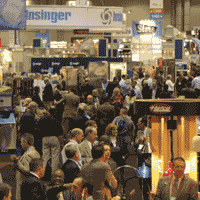NAFEM 2011 will herald an evolving foodservice equipment scene, Feb. 10-12
The heat is on in Orlando, Fla., where residents are preparing to host more than the usual winter round-up of sun-worshippers. In fact, the tourism industry will get a spike Feb. 10, when manufacturers, operators, consultants and foodservice industry insiders gather for the biennial, highly touted NAFEM (North American Association of Food Equipment Manufacturers) Show, which runs at the Orange County Convention Center until Feb. 12.
“When we started NAFEM in 1973, we had 55,000 sq. ft. of exhibit space and 350 equipment manufacturers on display,” says Deirdre Flynn, NAFEM’s executive vice-president, from the show’s home base of Chicago. “This year it will be 330,000 square feet with 580 manufacturers. We’re showcasing about 95 per cent of the manufacturing available.”
Organizers and exhibitors are hopeful for positive results, agreeing that foodservice operators are emerging from the doldrums caused by the recession
and proceeding with cautious optimism. Energy efficiency and labour savings will continue to dominate operators’ wish list in 2011, as they look for ways to reduce costs, improve safety and hygiene and eliminate maintenance headaches. But that’s not all that will be on operators’ minds as they view the latest and greatest from the equipment industry.
CLIMATE CHANGE
According to Brad Barnes, senior director of Culinary Education for The Culinary Institute of America in Hyde Park, N.Y., and keynote speaker at NAFEM 2011, attitudes are clearly changing. “We’re in a real flux in the culinary industry. People are looking at a lot of different ways to prepare, hold and serve food. At the same time, there are serious demands on businesses to be efficient and effective at less cost while maintaining their profit models.”
“For the past two years, the industry’s focus has been on equipment replacement and refurbishing,” says Flynn. “On the commercial side, however, we’re now seeing projects come to fruition and new restaurant openings.”
As the economy comes back, Flynn reports non-commercial sectors, such as hospitals, universities, healthcare and corrections are starting to see growth, largely due to new builds and renovation projects within existing dining facilities. “This year there’s a big influx of foodservice vendors catering to the campus and healthcare environments.”
Although product details from the show are sparse, prepared-food is already being pegged as a notable trend likely to be seen at the show. Michael Whiteley, vice-president of Sales and Marketing for Hatco Corporation in Milwaukee, has noted significant growth in home-meal replacement at chain stores. “We’ve seen an increased number of operators wanting to offer items such as pizza by the slice, hot sandwiches and breakfast foods. That has grown demand for selfserve cabinets and hot cases to attract impulse sales.”
Beverage trends are also sure to be a hot-button issue. “McDonald’s McCafé, for example, is all about coffee and espresso. Fruit beverages and smoothies are a fast-growing category for chains of all sizes,” says Thomas Campion, president of the Smyrna, Tenn.-based Franke Foodservice Systems Inc., and NAFEM president-elect.
MIGRATING MENUS
Equipment flexibility and versatility will be another theme at the how this year. “Visitors will see lots of innovation in products that carry a smaller footprint and have greater durability. Multi-purpose equipment that allows operators to adapt to customer demands is still big, as the cost of real estate continues to rise,” Flynn surmises.“[Operators] want equipment that can adapt to menu changes driven by customer demand and re-concept the same space without having to rebuild.”
The Culinary Institute’s Barnes agrees. “Culinarians are trying to understand the various [menu] styles and capture their popularity while they’re hot, but they need the right equipment to match what they are being challenged to present to customers.” Menu changes are especially top of mind on the QSR side. “[It’s]
driving increased traffic, so operators are looking for equipment that makes it easier to run more complicated menus. At the heart of this change is the need for equipment that is intelligent and easy to use,” NAFEM’s Campion adds.
EASY DOES IT
Although, a variety of equipment that offers simplicity in operation and performance is paramount, “Operators want equipment that’s set up to push a button, set a cycle and tell you when food is ready.Anything that’s easier to clean, take apart and put together means fewer guys in a truck showing up to fix it,” Campion says. It’s achieving that level of simplicity and efficiency that is the hardest, he adds. “Those things cost money, because there is more engineering involved. Operators have to [take] a leap of faith, because the more time your product is up and running, the more money you will make.”
As a result, this year, show attendees will see how simplicity is a driving factor behind the all-important issue of food sanitation. “You can expect to see more and more equipment that focuses on food safety and sanitation, worker safety and productivity,” says Steven Follett, CEO and president of Follett Corporation in Easton, Pa., and president of NAFEM. Anything that makes it easier to sanitize — such as self-cleaning features — helps operators with limited time and budgets call for outside help, he adds. These features also improve productivity and cater to labour shortages.
SAVING ENERGY
Of course, sustainability and energy savings have been an integral part of the operational picture for some time, and the show will demonstrate the trend doesn’t show any signs of abating. “Community responsibility is a big driver,” Barnes says. “We should all be making ourselves aware of our impact on the community, the labour force and the environment. We have to take into account how well we are meeting those needs.”
For their part, equipment manufacturers must do their due diligence to determine how to build equipment that meets the needs of the chef and helps control operating costs while still being mindful of the environment, Barnes adds. “The general populace within the industry may not be 100 per cent sure what they are looking for, but they will know when something offers good results with less energy.”
According to Hatco’s Whiteley, environmental responsibility has been a theme at the NAFEM Show for a number of years. “Anything in the realm of energy savings, sustainability, environmentally friendly, minimizing carbon footprint are big trends in terms of operator interest. All of the products we’re exhibiting have some element of that in their design.”
THINKING INSIDE THE BOX
Switching gears, ventilation will be another issue for operators to consider at the show. “The to-do list for anybody in charge of running a facility has nothing to do with cooking, serving, preparing or holding; it has to do more with the box you are working in. If that could be managed better, it doesn’t become an operational issue and everybody’s lives become simplified,”says Franke’s Campion.
ROUND UP
There will be many equipment solutions on display at the Florida Convention Centre in February that will address the big issues, Follett says. “Energy efficiency and water usage are top of mind. Visible diagnostic information for operator interface with equipment is big, especially as it relates to requirements for cleaning
and preventive maintenance and simple diagnostic information. The time to do these tasks is simply not sufficient, and equipment that addresses time-savings for workers is always a good thing. Solutions that address sanitary concerns will also be big. Given the continued trend for health-conscious menus, any equipment that supports cooking and serving of healthy foods will be popular, [too]. These are the types of innovation that are pretty much the price of admission for exhibitors at NAFEM.”
NAFEM Bits and Bites
FOR THE SECOND year in a row the main attraction at the NAFEM Show is expected to be the What’s Hot! What’s Cool! product gallery — an 8,800-sq.-ft. space in which each of the 120 companies selected will feature a product that fulfills a number of criteria, such as aesthetic impact, returns to the operator and revolutionary features, among others. Companies featured this year include: Blodgett Corporation, Cooper-Atkins Corporation, Follett Corporation, Elite Global Solutions and Alto-Shaam, Inc., to name a few.
NAFEM organizers have also revamped the show’s educational program to adopt a “more holistic view of what companies are doing,” says Deirdre Flynn, NAFEM executive vice-president. The educational program will focus on corporate responsibility, innovation and food, as well as flavour trends; each will be the feature topic for a day. A keynote address will be followed by breakout sessions. “We tried to focus on topics the foodservice community has said are the most important to them,” Flynn explains.“Ultimately, our goal is to enable people to spend the maximum amount of time with manufacturers on the floor.” New visitor technology tools, for example, will help guests better plan their time and cover more ground. Wayfinder stations will be available for downloading show information to handheld devices and cellphones. “There’s a lot to see, and we’re doing what we can to make it easier for visitors to connect with manufacturers,” says Flynn.
Speak Out
The following is a preview of this year’s NAFEM workshops:
• On Innovative Thinking: Peter Sheahan, entrepreneur and author of Flip: How to Turn Everything You Know on Its Head — and Succeed Beyond Your Wildest Imaginings
• On Corporate Responsibility: Tim Sanders, author of Saving The World at Work and CEO, Deeper Media, Inc.
• On Future Trends: Brad Barnes, certified master chef, The Culinary Institute of America and NAFEM professor of Culinary Arts





















